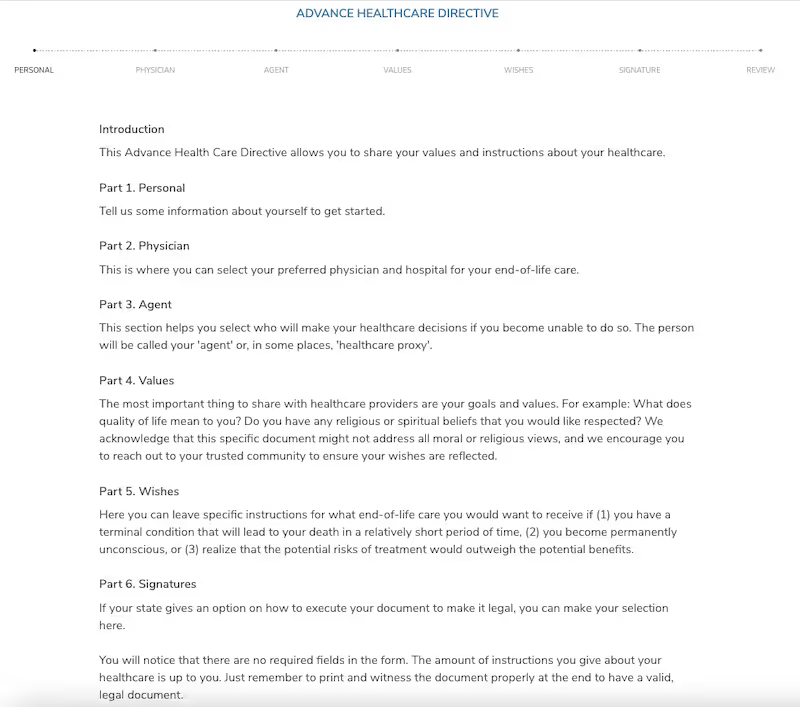Despite its name, a living will isn’t actually a will. The definition of a living will is a legal document that lets you outline your end-of-life healthcare preferences in case you’re unable to communicate them. For example, your living will would go into effect if you were in a coma or unconscious.
In a living will, you specify which medical treatments, procedures, and medications you do or do not want to receive. By making these decisions when you’re healthy, you take the burden of these choices off of your loved ones, who may struggle because they don’t know what you want.
Living wills are sometimes known as medical directives or advance healthcare directives (AHCD). A living will can be part of a series of legal documents that help you outline your healthcare wishes. You can create a living will for free through FreeWill.
Living will vs. will: What’s the difference?
A will — or a last will and testament — is a legal document that describes how you want your property and other assets distributed after your death. You can also use a will to choose guardians for your minor children, if you have any.
So what’s the difference between a living will and a will? A will is used after you die, to distribute your property. A living will is used while you’re alive, to explain what kinds of healthcare procedures and medications you want.
Living will vs. medical power of attorney: What’s the difference?
A medical power of attorney (POA) is a legal document that lets you choose someone to make medical decisions for you if you can’t make them yourself. In some states, this person might be called your healthcare proxy, agent, or representative.
With a living will, you outline which medical treatments you do or do not want to receive. With a medical POA, you choose someone to make those decisions for you.
These two documents can work together: if you have a living will and a medical POA, then the decisions your healthcare proxy makes must align with the wishes in your living will. It’s important to note that a living will overrides a POA, since a living will is a direct statement of your healthcare wishes. For example, imagine if your daughter is your healthcare proxy and wants to put you on a ventilator while you’re unable to communicate. However, you have specified in your living will that you don’t want ventilation. The doctors will honor what’s in your living will above your daughter’s wishes.
Living will vs. advance directive: What’s the difference?
An advance directive, or advance healthcare directive, is a document that combines a living will and a medical power of attorney. In other words, living wills are one part of an advance directive.
The names for advance directives vary from state to state and are sometimes used interchangeably, which can be confusing for some people. In some states, POLST and do not resuscitate orders are considered additional types of advance directives. It's a good idea to understand which terms your state uses for these documents, so you know which forms are relevant to your situation.
When does a living will go into effect?
A living will only goes into effect when you’re alive but can’t communicate. At this point, doctors will follow the instructions in your living will. Your living will has no authority as soon as you’re able to communicate again — for example, if you wake up from a coma.
What decisions are covered in a living will?
There are many different types of procedures and medications to consider when drafting your living will. Some of these could include:
- Breathing tubes or ventilators
- Feeding tubes
- Blood transfusions
- Dialysis (a treatment that takes over kidney function)
- Types of pain medications
- Organ donation
- If you have a medical condition, you could include instructions or information relevant to your situation
Although the thought of needing these procedures can be difficult to consider, making informed decisions now — when you’re healthy and clear-headed — can save your family from grief and uncertainty down the road. Using a living will template may prevent emotional overload and help you get started.

How do I make a living will?
For your living will document to be legally valid, you need to print, sign, and witness it (like you would with a last will and testament). Many states provide these forms for free, but they may be difficult to customize. If you create a living will on FreeWill, we provide a customizable framework for what to include in your living will, and instructions for making it legally valid.
While you may feel uncomfortable at the thought of outlining your end-of-life wishes, it’s one of the kindest things you can do for your loved ones. Knowing your wishes — especially when you’re unable to communicate them — provides peace and certainty during an uncertain time.
Interested in making a last will and testament instead? You can also do that for free through FreeWill. Get started here.
Make your free estate plan today

Make your free advance healthcare directive

Make your free durable power of attorney

Make a stock donation today

Make your free revocable living trust










